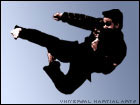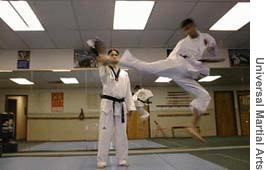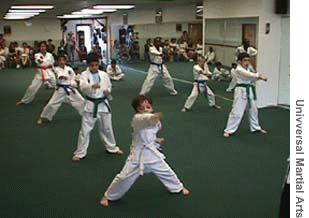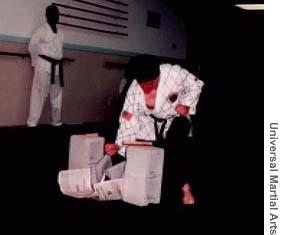|
Martial arts: Which one?
|
 |
October 17, 2001: 1:44 p.m. ET
Experts advise watching the teacher when considering martial arts
Allen Wastler
|
NEW YORK (CNNmoney) - So you want a little Bruce Lee in your attitude? Or maybe a little Zen? Perhaps it's just a case of looking for a more interesting way to get in shape? Whatever the reason, you're going to give the martial arts a spin. Now you have to figure out how.
It can be a daunting task with a real downside. Amid all the chops and kicks, belts and uniforms, ceremony and hype, there is real time and real money involved. Membership in a martial arts school can cost anywhere from $500 to $1,500 a year. How do you make sure your investment pays off?
| |

|
|
| |
|
This article originally appeared Feb. 7, 2000. The information has been updated.
|
|
|
"Martial arts is not a commodity product," warned Rob Colasanti, vice president of the National Association of Professional Martial Artists, a business association for martial arts schools. "Martial arts schools are diverse, even within the different styles. You need to do some comparison shopping."
Is it the art ...
The silken sashes of kung fu, the wood-splintering force of tae kwon do, the spiritual calm of tai chi -- choosing a martial art is the first question, and probably one of the more complicated decisions facing a potential student.
Individual martial arts styles are as varied as the cultures of the world. Japan, Korea, China, Brazil, the Philippines, Okinawa, and Israel, for example, all have one or more nationally recognized martial art style.
So before spending your money, do a little homework.

|
|
|
Some styles aren't for everyone. | |
Martial arts, regardless of the originating country, tend to fall into one of two categories, hard and soft.
Hard arts -- karate, tae kwon do, tang soo do, for example -- concentrate more on physical conditioning and forceful, rigid moves.
Soft arts -- like hap ki do, tai chi, and aikido -- promote the more spiritual aspects of martial arts and stress fluid, dance-like movements.
A potential student, experts advise, needs to look at what the different styles demand and offer. More importantly, the student -- or the parents of the student -- needs to figure out what he or she wants to accomplish: physical fitness, self-defense, lifestyle improvement, or spirituality.
The high stretch kicks of tae kwon do or the low, crouching stances of kung fu might be beyond the physical abilities of some people. On the other hand, the meditative nature of tai chi or the complicated inter-locking techniques of hap ki do could put off those who want an aggressive work out.
"You have to do what's right for you," said Walter Fricke, owner of Universal Martial Arts in Bloomfield, N.J. "You have to look at your needs, your body, your personality and figure out what's right for you."
... or the artist?
Just as important, perhaps more important, is the instructor.
"You could have an eighth dan (8th-degree black belt), grandmaster, world champion. Great credentials. The question is, what can he do for you?" said Fricke. "If he can't teach, if he can't get across what he knows, it's worthless."
All the experts advise potential students to visit schools and watch the classes.
"The important thing is not so much the style of martial art but the style of the instructor," said Colasanti. "Watch classes. Basic ones and advanced ones. See if it will match your preferences."

|
|
Watch some classes before joining a school. | |
Most martial arts studios and schools use a contract system similar to those used by health clubs -- typically there is an initiation fee and tuition that can be paid over time through a finance plan or in a lump sum. The time commitment makes it important that you know beforehand whether or not you will appreciate the type of instruction.
Watching a class is also likely to reveal whether or not the instructor is qualified. Diplomas and association certificates on the walls often don't mean much, the experts warn.
"A lot of certificates are hokey," said Colasanti.
Some owners make up associations or buy into martial arts marketing organizations in an effort to pump up the prestige of their school.
"You can pick up a black belt at any martial arts store or get a certificate made by mail," said Buddy Amato, owner of Amato's Karate and Weapons Academy in Keansberg, N.J.
Regulation debate
Martial arts schools do not fall under any special state or federal regulations. In fact, efforts to regulate the industry are a continuing source of controversy.
"You need a license to cut hair, but there's not even a background check requirement for (martial arts) instructors," Amato, who has championed some past New Jersey initiatives, pointed out. That, he says, should be of particular concern to parents looking to enroll children in martial arts classes.
School owners, Colasanti counters, have legitimate concerns about legislators with little martial arts knowledge trying to establish standards across the industry. His association, with over 2,100 school members, recently launched a certification program for instructors aimed at alleviating some of the concerns that prompt calls for regulation.
Don't just look at the qualifications of the owner or chief instructor, the experts advise. Check out the teaching style of all the black belts and high belts. Those are the ones who will likely be teaching the beginners on a regular basis.
In addition, check out the "spread" of students. Are there lots of white and yellow belts, but hardly any greens, blues, purples and browns? That may be a clue that students leave the school after a short time.

|
|
|
Concentrate on what you want. | |
Are there a variety of classes? Kids' classes, meditation classes, aerobic kickboxing can round out a curriculum and make a membership more attractive.
What kind of equipment or uniforms is required? The answer could add substantially to the price of membership. Also, is there a fee for tests?
Is the school doing good business? Without students, schools fold -- and they could take any money you paid in advance with them. "You need to look at the level of customer service," Colasanti said.
Behind all the bravado and mystique, the experts point out, martial arts schools are still businesses. When joining one, be businesslike, they advise. 
Click here to send mail to tae kwon do black belt Alan Wastler.
|
|
|
|
|
 |

|

